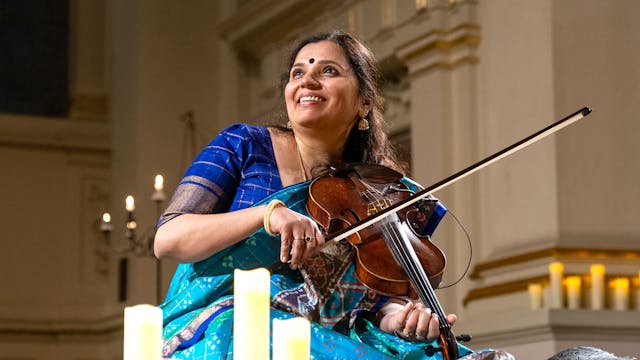Ranjani and Gayatri | Raga Chandrakauns
Evening Ragas
•
10m
Recorded at Darbar Festival 2015, on 18th September, at the Purcell Room of London's Southbank Centre.
Musicians:
- Ranjani & Gayatri (vocals)
- HN Bhaskar (violin)
- Sai Giridhar (mridangam)
- Giridhar Udupa (ghatam)
- Mithila Sarma & Kiruthika Nadarajah (tanpuras)
Raga Chandrakauns
Renowned for the lyrical luminosity and purity with which they continue to present Carnatic music to audiences around the world, Ranjani and Gayatri’s performance from this Darbar festival 2015 video is a firecracker that will be remembered for years. As siblings who embarked on their musical journeys hand-in-hand, they are blessed with an extraordinary timbre and an infectious personality on stage.
HN Bhaskar’s support on the violin is ripe with patient refrains, varied melodic improvisations and a strong sense of rhythm.
Sai Giridhar (mridangam) and Giridhar Udupa (ghatam) interlace the melody with a meticulously woven rhythmic support that calibrates mindfully to the music in delicate and robust crests and troughs.
The sisters end their recital with a resounding abhang set to Raga Chandrakauns in an extraordinary trade of energies between themselves and their accompanists on stage.
Up Next in Evening Ragas
-
Irshad Khan | Darbari Kanada
Recorded at Darbar Festival 2008, on 4th April, at the Phoenix Theatre, Leicester.
Musicians:
- Ustad Irshad Khan (Surbahar)
- Sukhwinder Singh (Jori)
- Debipriya Das (Tanpura)Raag Darbari Kanada; Thaat: Asavari; Samay: Midnight
The surbahar’s deep-toned strings are set on a broad neck, a...
-
Kala Ramnath | Raag Basant
Recorded at St Martin-in-the-Fields at a candlelight concert on 21st March 2024.
Musicians:
- Kala Ramnath (Violin)
- Gurdain Rayatt (Tabla)Raag Basant; Thaat: Bhairavi; Samay: Midnight
Drawing from centuries-old traditions yet imbued with a contemporary spirit, their collaboration promises t...
-
Kala Ramnath | Raag Darbari
Recorded at St Martin-in-the-Fields at a candlelight concert on 21st March 2024.
Musicians:
- Kala Ramnath (Violin)
- Gurdain Rayatt (Tabla)Raag Darbari; Thaat: Asavari; Samay: Midnight
Drawing from centuries-old traditions yet imbued with a contemporary spirit, their collaboration promises t...



